Beasts of the Northern Wild | All About Greenhead Flies
Come mid-July, greenhead flies descend upon the beaches of New England. Learn more about these fierce, hungry, bloodsucking flies.
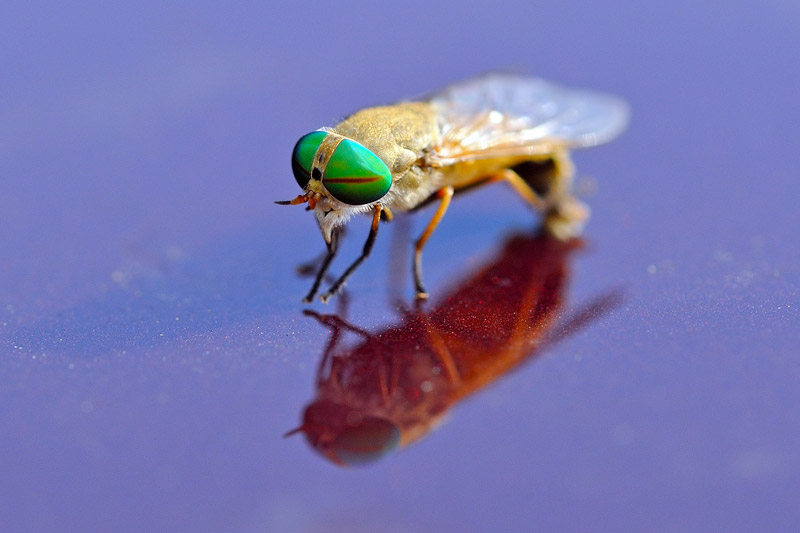
Closeup photo of a greenhead horsefly.
Photo Credit:Greenhead flies, named for their large, bright green eyes, can be found in the coastal marshes of Eastern North America. Unfortunately for us, that means they love New England’s beaches. Knowing about these pests can help you plan your next beach trip the safe way — away from the painful bites of greenhead flies.
The wild serenity of the salt marsh stretches from Maine to Florida. It is a world caught between worlds, a lovely transitional swath of emerald grass that snakes along the Atlantic coastline, occupying a territory somewhere between sea and solid ground.
This line of demarcation between solid and liquid is neither and both. The ground of the salt marsh is springy, like walking on a lumpy trampoline. Water oozes up through tufts of matted grass, potholes lurk beneath seemingly solid ground.
Who inhabits this spongy world? Apart from the occasional deer, there are turtles, assorted birds, mice, and, once in a while, a rabbit, a raccoon, or an otter, mostly just passing through. Which means it’s slim pickings for one small, hungry inhabitant, whose appetite revs into high gear ’round about mid-July.
Like ripening fruit at the moment of perfection, Tabanus nigrovittatus emerges from the salt marsh at summer’s midpoint. She has just laid her first batch of eggs. Two hundred or so microscopic dots, but who’s counting, because right now she’s out of her mind with hunger, and it’s time to get down to the business at hand. Her first blood meal. Ever. In her young adult life she’s never had a solid meal, subsisting mostly on nectar, preferring to wait until the whole egg-laying business is behind her. By doing so, she ensures that the precious bloodline will continue, that the next generation of greenhead flies–as she is more commonly known–will be born. But right now she’s paying the price. And there’s not a thing to eat.
A stone’s throw from the unearthly beauty of the salt marsh, some of the great New England beaches sprawl beside the Atlantic, baking in the sun: Crane Beach, in Ipswich; Plum Island, off the coast of northeastern Massachusetts; Hammonasset Beach, unfurling along the Connecticut side of Long Island Sound. A brilliant blue sky stretches overhead; a faint breeze ruffles the grasses. Perfect beach weather. A great day to fly. Her dazzling green eyes casting about, she makes a beeline for the water. The sand up ahead is swarming with warm, scantily clothed bodies, fairly bursting with reservoirs of succulent human blood.
“Greenheads,” says the blond boy barricaded in the entrance booth at Hammonasset Beach State Park. He slides open a window and points to a squashed bug taped to the side of the building. “They’re pretty bad today. You may want to think about it.”
Given the size and spread of the flattened insect, “pretty bad” seems like a PR understatement. The little torpedo is more than half as long as my thumb, and even mashed up it’s easy to imagine hordes of greenhead flies making for the beach like vacationers racing to claim their patch of sand. Like most beachgoers, tabanids prefer warm, sunny days, and it is, of course, an especially beautiful July morning, without even a hint of breeze. The sun is already fierce, the distant sand shimmers with promise, and the sea is as blue as the Aegean.
But a face-off with greenhead flies? Their size makes them fairly immune to bug repellent, and slathering on DEET isn’t a very appealing option. Do I want to spend a day swatting these things? I squint at this poster child for a bad day at the beach, weighing the pros and cons. In full knowledge that at this very moment, a similar scenario is playing out, up and down the East Coast. Cars backing up, just as I’m about to do, turning around and heading home. Or at the very least, somewhere far from the coastal salt marshes.
And that’s when I get curious.
What’s up with this bug? Clearly it’s a robust type of horsefly (the name is a tip-off), and it certainly outweighs its relative the deerfly, although both biters belong to the same fly family, Tabanidae. And “greenhead” obviously refers to its enormous green eyes, laced with bands of iridescent red or purple.
But above and beyond these physical characteristics, and the fact that greenhead flies will indiscriminately attack horses, cows, dogs, hogs, and deer, this fly is notorious mainly for one thing: the pain it inflicts in large numbers on beachgoers at the height of summer. Make that two things, because like The Terminator, this fly is relentless. It will not stop until someone pays the price.
Stories of encounters with greenheads have a dramatic quality usually reserved for plays written by one-name ancient Greeks. But the blunt truth is that these creatures can ruin a day, or days, at the beach.
Often during peak greenhead season–generally early or mid-July to mid-August–beaches will post warnings about fly conditions, like some weird variation on the surf report. At Crane Beach there’s another sign, too: No Refunds. But it’s not about singling out one beach or another; any gathering spot near a salt marsh–beach, restaurant, or home–is potentially vulnerable. Sometimes it’s just a matter of degree.
“All salt marshes on Cape Cod provide habitat for greenhead flies,” says Gabrielle Sakolsky, entomologist and assistant superintendent at the Cape Cod Mosquito Control Project. “Our largest marshes, adjacent to the large barrier beaches of Sandy Neck and Nauset, are the worst, because they have the largest amount of larval habitat. There are no immune spots.”
If that’s the case, I suddenly have more questions. Can greenheads be outsmarted? What makes them so rabid in the first place? Why is the pain so fierce? And don’t we have any options?
In search of answers, I’ve found myself knee-deep in a salt marsh with John Stoffolano, Ph.D., professor of entomology at UMass Amherst. It’s early August: prime tabanid time.

Photo Credit : Annie Graves
Every summer, Dr. Stoffolano and his students head into the dark heart of greenhead territory–the broad and glorious salt marshes that spread out around Pine Island, in Newbury, Massachusetts, not far from Crane Beach. Here they collect thousands of flies from the shiny black wooden boxes that stagger on slender legs across the marsh, like dark, square animals imagined by a Cubist carpenter. Back at UMass, they conduct research on greenhead behavior and physiology. “We’re the only ones doing this kind of work,” Dr. Stoffolano told me when I first visited his office in Amherst, months earlier. “At one time there was a lot of interest.”
That was before scientists learned that tabanids do not in fact carry Lyme disease or AIDS, that they’re merely a horrible nuisance. But in the 30-plus years he’s been researching these greenhead flies, Dr. Stoffolano has learned a lot, and he’s got the office to prove it. Bookshelves overflow with the chaos of his profession–research materials, scientific papers (many his own), and reference books–the contents spilling onto the floor, the desktop, any available surface.
In sharp contrast to its occupant, who is neat, self-contained, and, it turns out, pretty funny, with an adventurous streak. Tales of tsetse flies in South Africa, encounters with biting beach flies in the Seychelles, and experiences at a Zulu healing ceremony weave in and around talk of greenhead flies. His mother is part Mohawk Indian, and Dr. Stoffolano’s interest in indigenous cultures and insects has gradually evolved into a college course on cultural entomology, in which he uses insects to teach diversity, while incorporating references to art, music, mythology, and archaeology. Traces of Indiana Jones, minus the bullwhip.
Over the next few hours, I get a crash course in greenhead flies: Tabanids 101, if you will. For instance, I learn that the males don’t bite. Only the female is out for blood, but when she first takes flight, she’s actually a vegetarian. It’s a little like hearing that sharks prefer salad. (The seeds of bloodlust are sown early, though; the larvae are carnivorous and cannibalistic, and if there’s nothing else handy, like an earthworm or some other type of larva, they’ll eat each other.)
“Before she’s laid her eggs, you can even let her take a walk on you,” Dr. Stoffolano insists. “When the males and females emerge from the pupa stage, they feed on carbohydrates, like nectar or honeydew, for energy, for flight. That’s their gasoline. But once the female lays her eggs, her whole behavior changes. She becomes extremely aggressive. In this second cycle she’s seeking a host–cow, deer, human. She needs to have a blood meal if she’s going to lay another batch of eggs.”
Then he shows me the photos. And now I understand why it hurts.
Unlike the delicate mosquito, which is a vessel or capillary feeder, drawing blood much like a syringe does, tabanids are pool feeders, meaning they sever lots of capillaries at once, in order to create a gaping wound so that the blood can pour out. Close-ups of the greenhead’s tiny mandibles reveal an unsettling similarity to a pair of deadly, razor-sharp scissors, able to slice through skin like a knife through mayo. Tiny temperature receptors on the insect’s antennae have already detected whether or not the host is warm-blooded. Now that she’s attached, two other mouthparts pull her head deeper and deeper. She’ll keep on sucking until you smack her away. Then she’ll come back for more. Over and over and over.
At first, according to Dr. Stoffolano, it doesn’t hurt. “I’ve watched them go all the way down into my hand,” he says matter-of-factly. “They probe the skin for temperature, then they pierce the skin, and then they salivate. The saliva contains an anticoagulant so that the blood doesn’t clot. As soon as they release saliva, which is a foreign protein, our bodies react to it and we sense pain. That’s when we swat ’em.”
Pain is the greenhead’s great enemy. The very thing she does so well keeps her forever hungry: The viciousness of her bite practically guarantees that it will be difficult for this insect to get a good meal. But here’s where Nature’s brilliant adaptability comes through, letting the greenhead make the best of a bad deal.
“There’s not a lot of blood out on the salt marsh,” Dr. Stoffolano says. “They probably never get a good blood meal. So they’ve evolved a strategy of being able to lay the first egg batch without taking a blood meal. And that’s one of the major problems in controlling this fly. You’ve seen all the traps, right?” I nod my head. Anyone who’s driven the East Coast during the summer months can’t miss the black boxes strewn about the salt marshes up and down the Atlantic. “All those females that go into the traps have already laid a batch of eggs first. So you’re not cutting down on the population. What you’re cutting down on is the biting frequency and the nuisance factor. The traps are nuisance control.”
Which is still better than nothing, he acknowledges. Greenhead adults live three to four weeks, so the population builds up. They’re strong fliers, too, so if they can’t find a meal at the beach, they’ll fly a couple of miles inland. And although on a good day a greenhead can lay up to 200 eggs in what may be her first and last reproductive act, these dark, heavy traps–painted black to mimic large animals, like cows–can attract and capture up to 1,000 greenheads per hour. That’s good news for beachgoers, boaters, and anyone who lives nearby.
Frankly, short of spraying the entire East Coast, there aren’t a lot of other options. The insects themselves are too big to eliminate without using massive amounts of pesticides, which would damage the delicate salt-marsh habitat. Besides, greenhead flies play a couple of important roles within that fragile ecosystem. First, as an indicator of marsh health. And second, as a food source: Their spring larvae are consumed by shorebirds and fish, while adult greenhead flies are protein for purple martins and tree swallows. Eat or be eaten.
“The other problem we face with these greenheads is the vastness of the salt marsh,” Dr. Stoffolano adds. “It goes from Texas all the way around Florida, all the way up the East Coast, up into Nova Scotia. It’s a huge area. How do you control such a vast area?”
Meanwhile, I’m about to visit my first trap. I’m wading through thigh-high grass with Dr. Stoffolano and his wife, Susan, headed toward one of the greenhead traps alongside the road that cuts through the marsh around Pine Island. I’m wearing light-colored clothing, because greenhead flies zero in on dark, moving objects, and I’m covered head to toe, despite the blazing heat. We approach the first black box–it’s buzzing audibly.
“That’s a sound you don’t want to hear,” Susan Stoffolano observes, as we peer through the thick screen on the top of the box, reinforced so that birds can’t tear it apart to get at the insects. Inside, the box is crawling with tabanids, and two interior troughs are littered with corpses. There’s no bait; the insects enter from below, fly up to the light, and then can’t figure out how to exit. (The Northeast Massachusetts Mosquito Control & Wetlands Management District installs and maintains the boxes, but lets Dr. Stoffolano remove greenhead flies as needed.)
Together, he and his wife unscrew a corner of the trap, drape towels over sections to direct the flow of insects, and position a mesh carrier over the opening. Low-tech, but it works. It quickly fills with live flies, and we move on to the next trap. A steady breeze blows, keeping us mostly fly free.
Listening to all this buzz reminds me of a story Dr. Stoffolano told me about how horses were once used on the marsh around Pine Island to help cut salt-marsh hay, which even today is prized by gardeners for inhibiting weeds: “They made nets out of ropes that completely covered the horse, so that as the horse moved, it would dislodge any tabanids that were trying to bite.” And even in modern times, rumor has it that sometimes the postmen around Newbury and Pine Island will balk at delivering the mail, because greenhead flies are attracted to the moving mail truck and get trapped inside with its unlucky driver.
So what’s a human to do? I ask the horsefly expert for any words of wisdom, recommendations, last-minute thoughts.
“If it’s the season of the fly in your area, you gotta wear light-colored, protective clothing,” he replies. “They can’t bite through your clothes. And I would suggest that more beaches post Web sites. If it’s a heavy day for greenheads, don’t show up at the beach; you’re wasting your money. Forget about it. If you’re a restaurant, and you don’t want people sitting outside to be bitten, then you put traps up.”
His hand flashes before me, and with a graceful swipe he captures a renegade greenhead, crawling on top of the trap. “They’re beautiful creatures, aren’t they?” he smiles. He’s gripping the insect in a sort of tiny Heimlich maneuver, so that it can’t bite him, and then he holds it up to my face for a closer look. I’m staring into a pair of huge (relatively speaking) green eyes. “Look at those eyes,” he marvels, and then releases it.
Two hundred more eggs, if she gets a solid meal, I think to myself. And we watch her fly away.
Has your vacation ever been impacted by greenhead flies? Tell us about it!




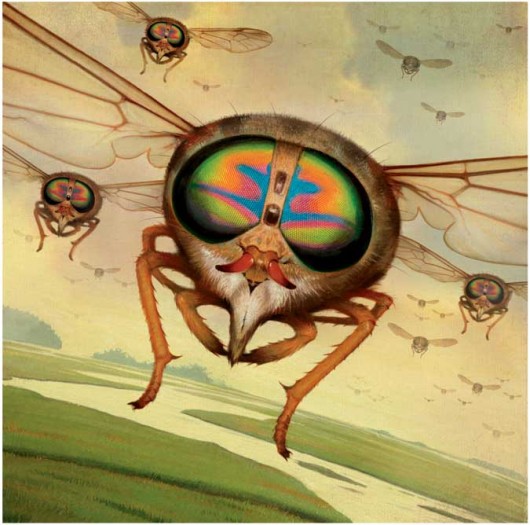

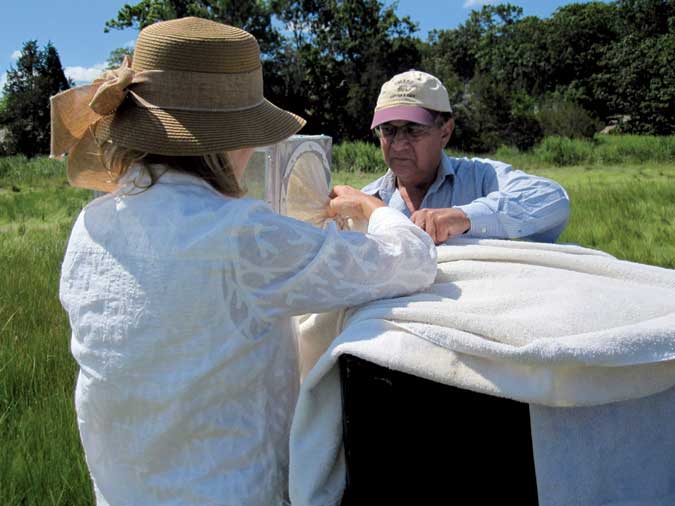
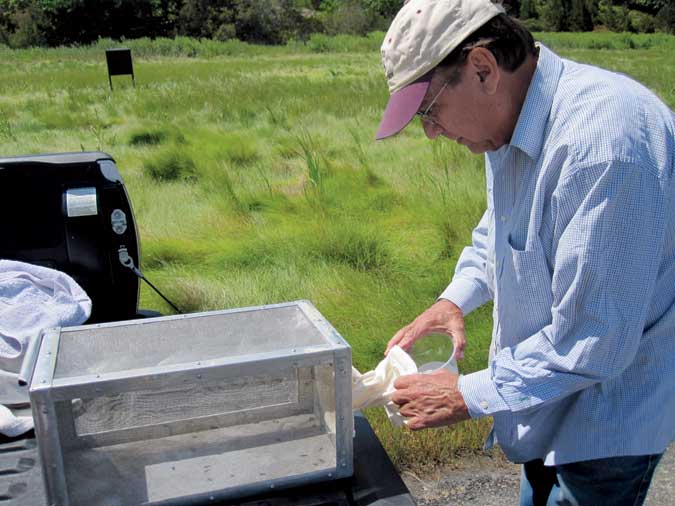

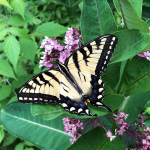


Great article I just read as I had to retreat to indoors because of how vicious the greenheads are today. I thought that they arrived on the new moon the end of June & were gone by the full moon high tide in July, which is tonight! Guess maybe that’s not true, maybe it’s the full moon in August?? Sure is a miserable few weeks and they certainly are nasty bighters!! Very informative article though,
I go to Cape Cod and some days green flies make it unbearable on Nauset Beach. Then we have Plovers nesting resulting in the closure of the beaches. It’s maddening!!
Hi Helen… Do you know if the green heads are still bad right now? Michelle 🙂
I live in South Jersey and the only thing that works for me 100% no greenheads is…when the wind blows from the East (off the ocean). This keeps them at bay, literally. Lol
The absolute worst time to go to the beach between June-September is when the wind blows from the West (off the land).
I believe you’ll be fine with little to no flys if it blows from other directions too. IF the wind changes from the West while your there, a few flys MAY appear but leave right when it changes again.
Since I live close enough to the beach to drive down for a day trip, I just check my Weather App the day before and morning of to see which direction the wind is blowing. I guess for those of you who go to the beach for more than one day on vacation, this method won’t help you that much.
In that case, I’ve heard from many people that Avon’s Skin So Soft works as a repellent…I think they even have a bug repellent that’s water resistant with SPF 30, and anti-itch relief.
Just read the article. I hate these flies more than anything! They ruin our summers here in Newbury, Ma. The island referenced above is not Pine Island, but Plum Island. The greenheads near our home are horrible, and they have started early this year. We usually don’t see them for another couple weeks. 🙁
Another reason to get a pool.
They are bad at pools too. I live near a marsh on Cape Cod and have a built in pool in the back yard. No escape…
Spectacular article!!
I’ve never heard of greenheads.. Read about them in a book & googled it.
I found this article there. At first, I was tempted to move on because I was just looking for more info on them..habitat, photos, etc.
However, this article was so well written I had to keep reading..all 4pages!
Nicely done, Ms. Annie Graves!!
They used to get us on Shirley, Long Island, where we would go flaming and crabbing when I was a kid in the 70s. Horrible little monsters, so fast and evil.
Living right next to a salt marsh with a pool,we are not able to use the pool the last two weeks in July each year due to these mini monsters. We actually go to the beach because they aren’t bad there. I wish these researchers could invent a safe repellent that works.
Greenies are in season from the first full moon in July through the next full moon. This is an odd case wherein the Hebrew calendar, based on lunar cycles, always works — with greenhead season starting out on the 15th of the month of Tammuz and ending on the 15th of Av. If it is extremely hot weather I have seen them come out a few days early, but by that second full moon — 15th of Av — they are all done.
It’s Pine Island. Follow Pine Island Road off Route 1A.
Just ended a vacation on Sagamore Beach,MA starting July 23, 2016 during full moon week. The green head flies were vicious most days and ruined it for us. We were not aware of the nuisance they create nor prepared for the biting pain. On the second day we armed ourselves as best we could with bug repellent (OFF)…it helped but had to be frequently reapplied. Never experienced these nasty biters in years past in other beach towns on the Cape. Must be proximity to salt water marshes to avoid.
These little suckers take chunks out of me every summer. I hate them.
It was 1988. My mother was driving home from Easter church service when a drunk driver swerved into her and she lost control of the automobile. She died immediately upon impact. My family was very distraught at this senseless and sudden event in our lives. After months and months of police work done by the excellent detectives from our little community, we were finally given some closure of the driver who took our loved one so very early. When i looked at the mugshot of the driver, i wasn’t surprised at all; just a nasty, dirty, good-for-nothin Greenhead. The worst. His big diseased eyes peered through us in the picture we were shown. At the trial he kept looking back at us with those droll, lifeless green eyes. He was sentenced to 25 years in San Quentin. We got a call sometime around 1991 to learn his bunkmate in his cell, a giant tennis shoe, dispensed the social justice we so dearly yearned for….
I live in New England and though I do not frequent the beaches anymore I do remember those dreaded greenheads from my youth… they could really spoil a day at the beach! I have however heard from many of my customers that Avon Skin-so-Soft Original bath oil is an effective defense to the dreaded greenhead. Many people swear by it, though it is not meant as a repellant there’s something about it’s mild herbal scent that the greenheads do not like.
I have an Awful reaction to their bites, yellow heads too. I’m on the Outer Banks, NC. It’s normally the first 2 weeks of June they’re here. Thank God it’s not longer!
I was in Killdeer Plains Wildlife Reserve in Wyandot and Marion Counties in Ohio on Saturday, June 16, and was bitten multiple times by this fly. It appears they are heading west! My granddaughter took a picture of one inside my car as proof that this was, indeed, the Greenhead Fly. I thought you might care to know. It could be that there are so many ponds and marsh areas in this reserve as the reason they are breeding here and not confined to the east coast. We are about 2 hours south of Lake Eric and considered in its watershed, so that can also account for their presence. It’s the first time I’ve ever seen one, though.
Fascinating read. Only false statement is they can’t bite through clothes. They have bitten me through my pants and through the fabric on a beach chair. I think you’d need scuba material or armor to stop them!!!
YES! They def bite through clothing. I recommend wearing white! White towels. White beach blanket, everything white etc. The only repellent that helps is cactus juice. I learned from Maine fishermen types. It’s not actual cactus juice. It’s a product called that. Not failsafe but works better than Off. A combo of Deep Woods Off and generous slathering of cactus juice plus white everything is the key!! Also fly swatter for revenge! Good luck
These mean Greenies are horrible!! Every summer when we take our boat out in the Great South Bay on Long Island, NY…these little jerks try to ruin our fun! My husband was bitten 8 times this past weekend….his face had golf ball size welts and his ankle was so swollen that he was having trouble putting weight on his foot. Amazingly, out of the 5 of us that day, he was the only one getting bit. We are always equipped with fly swatters! Wind definitely have an effect on their presence. As soon as we start moving on the boat and the breeze kicks up, theyre gone. I am so paranoid of the lil jerks and they completely have me on constant guard! Sometimes its so frustrating that I rather stay home! Wish there was a way to repel them!
We just spent 2 weeks on Ocracoke Island, OBX. arrived June 4th and the green heads where already in full military attack!!! It was horrible. Every day, no matter if there was wind or not. In any direction. We go every year the same time. This was the first time we had to deal with them.
Was bitten by my first Greenhead fly today in a Provincetown, MA and I instictly stumbled upon your article. I just arrived too by the water. I was laying out my towel on a chair and something quite large was flying around my feet. It was strange but I didn’t think anything of it. Before I knew it, she had landed on my foot, I swatted her away, and left was a centimeter-slice-like of blood where my leg meets my foot. I cursed! And thought what the heck was that?! Healed quickly with ice and not much bleeding. Doesn’t itch much either.
I’m in Cape Cod for a week on vacation and decided to take my family to Chapin Beach for the day. We spent an hour on the beach before we had enough of the greenheads and packed it in. They are vicious and relentless. At one point, while walking to the car I was being swarmed by 5, each getting their bites in. Apparently, I have some sort of allergy to them as the misery (intense itching at the bit site) has lasted for days. I’m from Georgia and this has been my first experience with greenflies. I will rethink my vacation destination in the future. No point in a beach vacation where you can’t enjoy the beach. In 7 days, I’ve spent an hour at the beach.
Most of the Jersey Shore is a salt marsh with a few barrier islands including Absecon Island (Atlantic City and Downbeach) and Brigantine. Yes they bite through clothes. Wind conditions determine “how bad they are”. And I just heard they come out and strike at night. Great article. Enjoy your beaches, crabbing, fishing and lobster all. Have plenty of alcohol and witch hazel on hand ; )
Living on Plum Island, MA, a few blocks away from the salt marsh I’ve been lucky to only have a couple of encounters with the mean Greenies. I too thought that the reference of Pine Island should have been Plum Island until I researched Pine Island and found it to be a small island in the salt marsh to the west of the Plum Island River. It’s no typo. There was a year that the traps were almost not placed in the marsh due to financials. A fund raiser was held to make certain the area was protected. Luckily in ten years I’ve only been bitten once and it was definitely painful!!!
We just spent a week in Orleans in Cape Cod, right near Skaket Beach. We’d walk to the beach every day and the green heads were definitely hungry! I got em probably 5 or 6 times and once one little sucker kept biting me through the mesh on the back of my camping chair…got me probably 3 times before I knew it was there and it escaped before I could avenge myself. I have swatted at least 3 maybe 4, but the score is definitely in their favor. I wish I remembered the skin so soft, my mom used to swear by it
We just moved from central Kentucky to southern Kentucky 4 years ago, (lake country) with our horses, and encountered these dreaded beasts. I had never seen or heard of these monsters, except for their larger cousins, the horse fly. The difference between them is the green heads are much more prolific! My thoroughbred (thin skinned) mare who is lighter colored then the rest has at least 20 new bites every day. Blood just drips off of her neck, chest, and torso. Fly spray does little to repel them. If anyone has an effective repellant please let me know!!!!
When I was a child I went to a summer camp in Chatham, MA. The camp was infested with them. After a week of bites, my skinny little legs swelled. They looked like big bags of potatoes. I could not move them and the pain was extreme. I spent the next five days in the hospital.
Here on Cape Cod, fly-catching boxes are painted blue. Flies begin to disappear with first high tide after full moon in August.
They can take a direct hit! You really have to wallop them hard to kill them!
Came to this article looking for information on the jerk that bit me today on my first day of vacation! I have a lump larger than my hand but luckily the bite didn’t hurt much at the time. And yes, they can take a direct hit and come right back. This one chased me down. Its only June 23 ( but in VA) Thank you for the information.
I understand that Native American Indians would apply bear fat/grease to their skin to discourage biting flies and mosquitoes. Perhaps the oil somehow mechanically blocks the biting apparatus. Baby Oil may serve the same purpose. Bourbon or Scotch might be helpful but you will need a designated driver if you are traveling to the beach.
Need to avoid the Cape beaches beside marshes from July through around the 2nd week of August to avoid becoming a walking buffet for these monsters. Schedule your Cape vacation for anytime after August 15th and you’re golden
I moved to Delaware seventeen years ago and they are all over the bay beaches at this moment! ????
I grew up in Salem, MA and this is the first time I have ever heard of the ‘greenheads’. We would go up to Crane Beach a couple of times during the summer and were never bothered by these critters. Maybe they weren’t around 65 plus years ago, I dunno.
We were on the Merrimack River this weekend and got attacked! You never get them much in Gloucester, MA but the closer you get to the salt marshes in Ipswich, Newbury etc the more of a problem they become!
I have never encountered these little monsters, thank goodness, but I thoroughly enjoyed reading your article. The worst flies that I have come across are horse flies but if these things have a worse bite…….
I had forgotten these from my young adulthood in Massachusetts at Cranes Beach and Good Harbour. Now enjoying our newly built house on a salt marsh on the Connecticut shore, and after a week of saying “What do you mean, horsefly?” – it all comes back to me, with a vengeance. Entertaining article, and a reminder to…consider the price of a glorious New England summer.
Great article, on the jersey shore we use these https://flycatch-r.com/ around the marsh areas, and anywhere there is a pattern of green head flies biting
I remember we had a swimming pond and every now and again, some huge biting fly would appear and terrorize the swimmers. We called them horse flies, but not sure what they were. Then there was the smaller horse flies, and also deer flies which were smaller still, and also,had green eyes. The largest “horse flies” didn’t have colorful eyes, and were a grayish color, and when they bit it was like someone was using the jaws of life on a person. The deer f,ies used to,chase us when we rode bikes, and they could really fly fast, keeping up with us easily. We’d go for a drive down dirt roads to get blueberries, and there would be a whole flock of them buzzing around the windows just daring us to step foot outside the car. We’d eventually get out, pick the berries, then head to the hospital for blood transfusions and stitches. We knew we had enkugn berries only when we started lassing out from blood loss. Got to the point where we needed shotguns to protect us from themflying wolf packs while picking berries. The deer flies would get,us duringmthe day, and the no see’ums would nearly finish us off at night, taking advantage of our weakened conditions due to the deer flies. Inmthe morning, the mosquitos would carry off the few who managed to survive the night. All in all though, the blueberry jelly was fantastic,,and would,give us enough strength to go back for more as soon as we were able to walk again.
Thanks for This Elaine – very funny. I really did LOL.
They certainly can spoil a beach day. I painted my Uncle’s home on 1A in Rowley and it was miserable. They bite right through the T-shirt. 1 1/2 stories up on a ladder, one hand on the ladder the other holding a paint brush…….
Very interesting article. Now I know why the bite of the green head is so painful. I used to take my girls to Crane Beach everyday in the summer. That is every day except green head season, then we stayed at the neighborhood pool!
To whoever it may concern. I have lived on the Jersey shore marsh area for 29 years and have discovered beyond a reasonable doubt that green-heads are attracted by heat. Not colors; that is, black boxes, black clothing, car engines, boat engines; all of which are heat producing products. For what it’s worth, that is what I found. Start your white colored vehicle, wait a few minutes and watch the flies start to hit the car.
Interesting article…. I hate those greenheads!!!
About 25 years ago, when we live on Cape Cod, we often visited my dad’s home in Chatham, located on a bluff looking out over Pleasant Bay. Right below his house was the marshy mouth of a small river. We rarely encountered greenheads, but one afternoon while hosting a Russian employee of the company I worked for, we were viciously attacked by greenheads. I’ve been bitten by a wide variety for bugs, from SE Asia, Australia, and throughout the USA, but those miserable (although truly amazing) flies league their victims with an extremely painful bite. I was bitten a number of times, on my legs and arms, and could still see the scars years later. I believe our Russian friend thought we had re-waged the Cold War since the flies seems to prefer him, who wore a dark blue shirt, over the rest of us. We moved inside and drank vodka.
About 25 years ago, when we live on Cape Cod, we often visited my dad’s home in Chatham, located on a bluff looking out over Pleasant Bay. Right below his house was the marshy mouth of a small river. We rarely encountered greenheads, but one afternoon while hosting a Russian employee of the company I worked for, we were viciously attacked by greenheads. I’ve been bitten by a wide variety for bugs, from SE Asia, Australia, and throughout the USA, but those miserable (although truly amazing) flies left their victims with an extremely painful bite. I was bitten a number of times, on my legs and arms, and could still see the scars years later. I believe our Russian friend thought we had re-waged the Cold War since the flies seems to prefer him, who wore a dark blue shirt, over the rest of us. We moved inside and drank vodka.